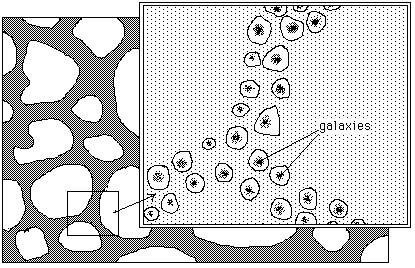
7) Some comments about the axioms.
...The classical General Relativity proposes a macroscopic description of the universe, shaped by the gravitational field. But, basically, the electromagnetic phenomena is not taken into account. In order to link this classical model to the observations, one has to bring the following additional axioms :
- The universe is filled by particles : neutral particles with a mass equal to m, and photons. Both contribute to the field.
- These particles move along geodesics of space-time
- A particle may send electromagnetic signal
- Another particle may receive this electromagnetic signal
- This electromagnetic signal, carried by photons, follows the null geodesics of space-time.
- A massive particle may send a gravitational signal, which is supposed to follow a null geodesic.
- A massive particle may receive this gravitational signal.
...So
that, for an observer composed by matter, the universe becomes optically perceptible,
according to these axioms. The photons are the go-between bringing an optical
message from a massive particle to another one.
...In the present model the universe is be considered as a cover of a S3 sphere, locally we have a structure similar to a bundled manifold, whose bundle should be limited to two values : + 1 and -1. Then we introduce the new following axioms.
- The universe is filled by particles : neutral particles whose mass is equal to m, and by photons. Both contribute to the field.
- The massive particles and the photon move along the
geodesic of space time and cannot cross from a region to the conjugated antipodal
region
of S3.
- A massive particle may send electromagnetic and gravitational signals, which can be received by another massive particle.
- The gravitational signal travels along the geodesics
of space-time, but also along the geodesics of the "adjacent folds of the
universe", "through the bundle structure" so that the gravitational signal
owns some sort of ubiquity, because it acts both in a region of the manifold
and in the antipodal region
(or in other terms in the "adjacent region", if we choose
the bundled manifold image ).
- The structure of the new field equation brings the following features.
...If a gravitational signal is emitted and received by two particles which "belong to the same fold" the phenomenon identifies with the classical description.
...But a gravitational signal emitted by a massive particle can be received by another particle located is the adjacent region (the antipodal region) , in other terms "through the bundle structure", the negative sign in the second member of the field equation changing the nature of the signal, as if it was emitted by a "negative mass".
- The electromagnetic signal follows the ordinary null geodesics of the manifold, but does not own this property of ubiquity. It cannot cross from a fold to the "adjacent fold through the bundle structure". To travel from a region of the manifold to the antipodal region, light has to do a complete half-turn of the S3 sphere.
...We confess that this proposed geometric description remains primitive and somewhat unclear. A correct description should imply a more refined model, including the gravitational and electromagnetic phenomena, i.e. an unified theory, which does not exist presently.
...The bundled manifold local description is similar to a 5d Kaluza model, in which the fifth dimension would be limited to two values + 1 and - 1, as suggested earlier by Alain Connes.
8) Estimation of the "missing mass effect".
Apply a perturbation method to the Euler equations :
(25)
with the first order solution :
(26)
The Poisson equation gives :
(27)
(27')
(28)
Lj is the classical Jeans length
(29)
(30)
This is the well known Helmoltz equation.
In classical steady-state approach we had
(31)
...The
interaction with the antipodal region shortens the Jeans length by a factor
1.414 so that we have a confinement effect. If we have a positive concentration
of matter dr in our space-time
fold, we will find a negative dr* in
the associated antipodal region, and vive-versa. The confinement of the mass
due to the action of the antipodal region should reduce the necessary mass
to balance pressure or centrifugal force by a factor :
